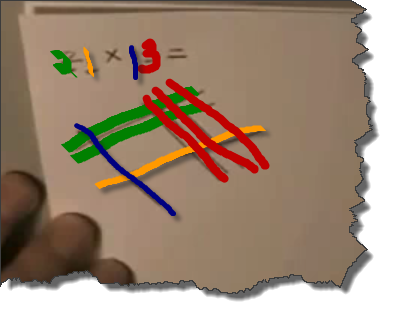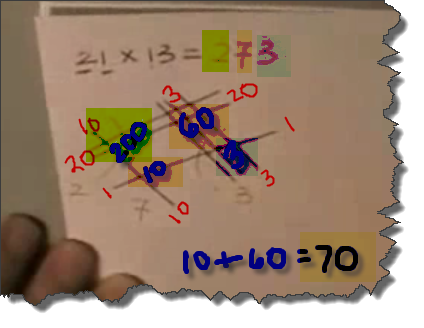I have come across some fun math problems (yes, math CAN be fun!) through the internet and friends. Here is a video of Japanese Multiplication. First watch the video, and then see if you can figure out how they are multiplying before you read my explanation below!
—————————————————————-
Well, did you figure it out? Let’s take a closer look at the first example:
- The first set of lines, the green ones in my image above, represent 2 sets of 10 , or 20
- The second region with one line, which is orange in my image, represents 1 set of 1
- Together these sets of lines, read top to bottom, represent 2×10 + 1×1 which is expanded notation for 21
Let’s look at the next set of lines that were drawn perpendicular to these lines:
- The first region that contains the 1 blue line represents 1 set of 10 or 1×10
- The second set of lines that were drawn, the three red lines, represent 3 sets of 1
- Together these 4 lines, read left to right, represent 1×10+3×1 = 13 in expanded notation.
Now for the tricky part!
 Those of you who have ever FOIL-ed in Algebra will recognize the process of distributing the values by “First, Outer, Inner, Last”
Those of you who have ever FOIL-ed in Algebra will recognize the process of distributing the values by “First, Outer, Inner, Last”
Here is a quick Algebra example to remind you
(x+3)(2x+5) =
First = x * 2x = 2x^2
Outer= x*5 = 5x
Inner = 3*2x = 6x
Last = 3*5 = 15
Then, 2x^2 + 5x +6x +15 = 2x^2 + 11x +15 (the Outer and Inner were “like” terms, so could be added together)
Now back to the arithmetic. If you look at the product 21×13 by separating out each factor by its place values, you have:
(20 + 1)(10 + 3) and now you can FOIL out the values, just like in the Algebra problem!
First = 20×10 = 200
Outer = 20×3 = 60
Inner = 1×10 = 10
Last = 1×3 = 3
The 200 is represented by the 2 sets of crossing lines circled in yellow on the image above- that location on the paper represents the hundreds place value, so having a 2 in the hundreds location represents 2×100 = 200. In the video a 2 is placed as the first digit of the product, which will be the hundreds place.
Next:
The 60 is represented by the 6 sets of crossing lines in green on the top right
The 10 is represented by the 1 set of crossing lines in green on the bottom left
Together the 60+10 gives 70. In the video, the areas circled in green on the image above both represent the tens place value, so they are adding up the 6 crossed marks and the 1 crossed mark to get 7 sets in the tens place, or 7×10=70. They then place a 7 to the right of the 2 in the product (placing it in the tens place)
Finally:
The 3 is represented by the 3 crossed marks in the lower right (circled in red on the image above). This area of the paper represents the ones place, so we have 3×1 = 3. They then place a 3 to the right of the 7 in the product, placing the 3 in the ones place.
This gives the final product of 200+60+10+3 or 200+70+3 = 273
~Now look at the second product in the video and see if you can figure out how it works!




Very interesting indeed. I wonder if anybody has any idea how old this technique is. I could not find any clue to this.
Though interesting that it really works, it is far to labour intensive to be practical. I took a stopwatch and solved a random 596 x 482 the classic pen and paper way and that took 25 seconds. A time the drawing method will never achieve I guess
It took me a minute to figure out how to multiply by hand again since it’s been so long. Also if you accidentally multiply wrong it can be a pain. It’s hard to count wrong… Just my opinion.
you’d still probably be faster if you did the single digit multiplication and then added the diagonals (e.g. did the drawing in your mind):
(5×4 =) 20 (5×8)= 40 10
36 72 18
24 48 12 (=6×2)
this method is really fun. but what about multiplying it with zero? (ex 302, 350… and the like)
That works to. You just need to remember where you’ve drawn 0 lines (or draw a dashed line to represent 0).
I still don’t quite see how to distinguish 101×101 from 11×11. Does one measure the distance from the 10**2 lines to the 10**0 lines?
It’s probably best demonstrated using large-squared graph paper. A three-digit by three-digit multiplication would take up a 3×3 section of squares. For the zeros leave the appropriate columns blank or use a dotted line for zero. Do not count anything where there is no line crossing nor intersections that include a dotted linelines that coss the dotted lines. Those would be zeros in the later addition.
I suppose it could be beneficial to kids (and adults) who have learning barriers such as those who learn and understand only through tangible visual aids.
Great information. Lucky me I recently found your site by accident (stumbleupon).
I have book-marked it for later!
I did this and it actually is very quick. Because I work with special needs children, this is actually an ideal way to teach them multiplication. For them, it’s very visual. I just cannot figure how to do it with a zero!!!!!!
[…] Source: Read Further […]
I am a special education teacher. I have many students who do not seem to be able to “memorize” their multiplication tables. I think this method would be helpful to them as it does not require memorization of the multiplication facts. In fact, it may, eventually, aid in such memorization.
I agree that a lot of visual and tactile methods will help all students. Memorizing math does not help them in the long run, but understanding the math through visualization will help them retain the information more readily.
I’m a 37 year old woman with a BFA and graduated magna cum laude. I still don’t know my multiplication tables! I learn differently and always had an issue with math. This is so simple! I also read to use a red pencil to represent the zero so you don’t get confused. Thank you for sharing!!!!
Logical explanation using place values but I wonder about the origin of the line intersects to indicate those multiples.